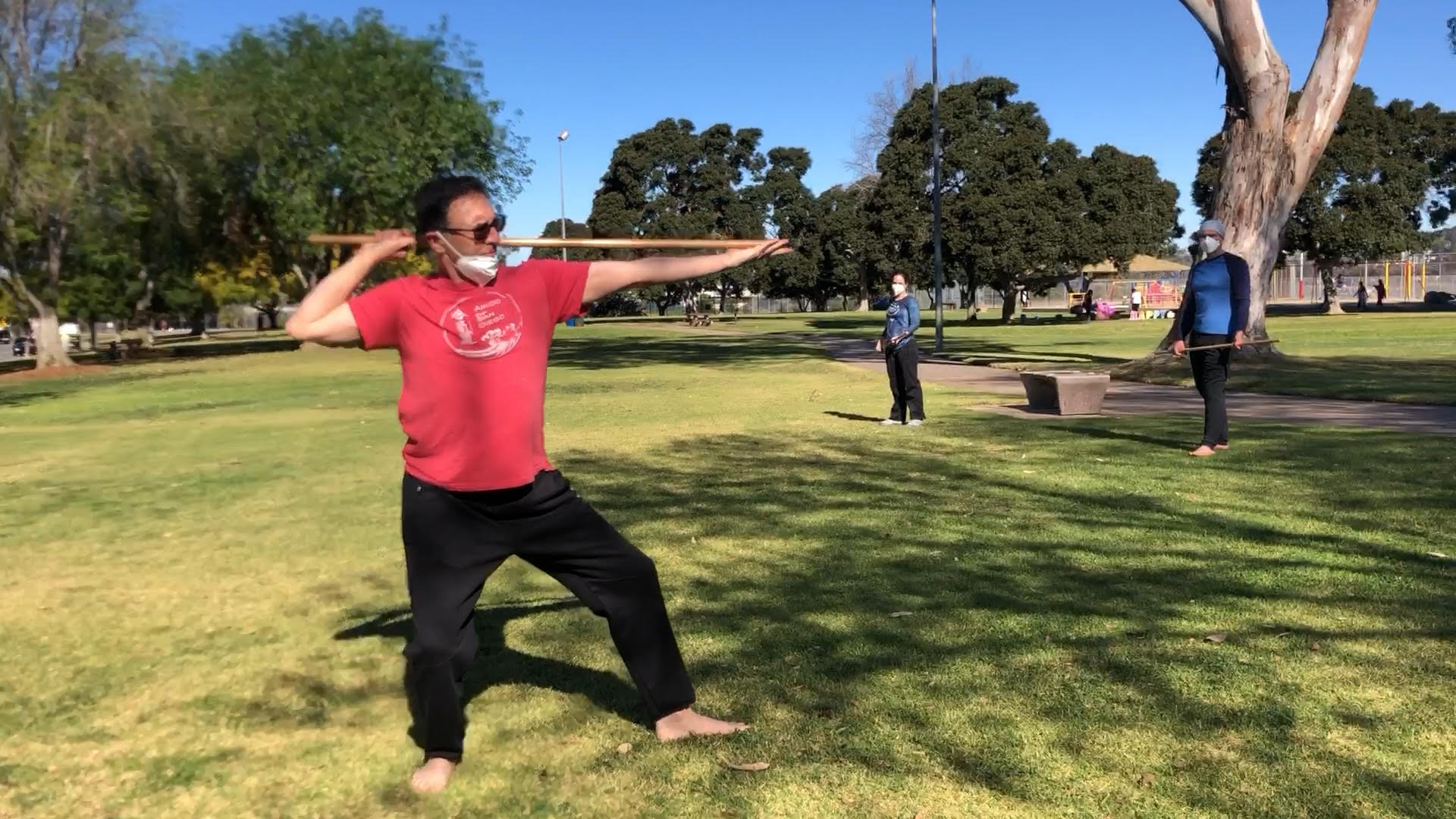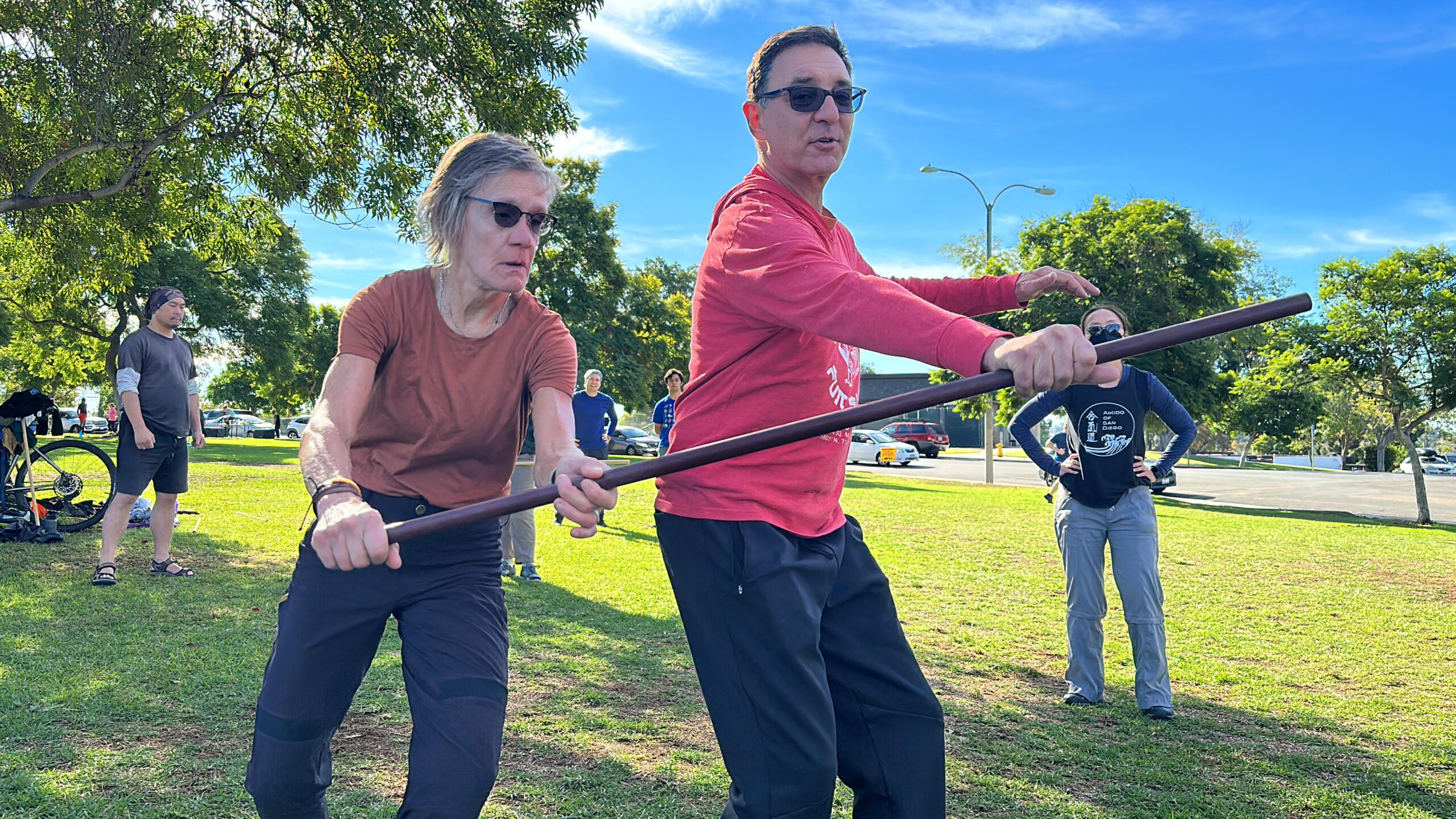I hadn’t planned on training with weapons at all, in fact. But then there was this one time I got my days mixed up, and I ended up in my first weapons class by mistake. When I first started in Aikido, weapons held no fascination for me at all. I never watched Samurai movies. I was not fascinated by Ninjas. OK, so yeah, I did have a throwing star when I was a kid, but that’s about as far as it went. I had no inclination to practice all that sword stuff.
But there I was at the dojo, warming up before what I thought was going to be a normal class, and Sensei said “Everybody grab a jo.” My first thought was “Oh, I wonder what we’re going to do with a jo? Maybe a connection exercise?” It slowly dawned on me… “Wait, what day is this? Oh, crap!” I was in an actual weapons class.
Turns out I loved it. Go figure.

Weapons Training Is Basic Training
Weapons training can help us understand empty-hand techniques better. It helps us develop better alignment and grounding. At our dojo we can start training in weapons right away — the classes are not reserved for advanced students. In fact one student recently did the weapons class as his very first-ever Aikido class, and he did fine.
Nervous About Training With “Sticks”?
Weapons work can seem mysterious. There’s additional confusing etiquette and tradition to figure out, and even more new words to learn. Plus there are people swinging sticks at you! It can be a little intimidating. So if you’re thinking about trying weapons classes, but are a little nervous about the whole thing, take heart, you will do just fine.
Here are 10 tips to help you jump in:
- In my experience at our dojo, just before class the instructor will announce which kind of weapon you will be using.
– The long, straight, round ones are jo [joh].
– The shorter curved ones with one flat edge are bokken [boh-ken — just like “broken,” but without the “r”]
– The little ones that look like wooden knives are tanto [tahn-toh].
If the instructor doesn’t say anything, look to see if they are holding a weapon, or if other students are all getting the same type from the rack or their bags. Those are good clues. It’s always fine to ask, too. - Just like in the old West (or present-day West, for that matter), where you don’t touch a horse or tack that isn’t yours, don’t mess with other people’s weapons. Most dojo have some school weapons — for any student to borrow. If you aren’t sure which are OK to use, ask. At Aikido of San Diego these are marked “ASD” on the end. The rest of the weapons belong to other students. At another local dojo there are separate racks for “public” and “private” weapons. A more senior student will be happy to help you pick one out if you aren’t sure what to do.
- How do students step onto the mat, and then off again after class? What I have seen people do most often is a standing bow toward the shomen, holding the weapon horizontally in front of them. At your dojo people may do seated bows. Keep your eyes open and follow the example of the senior students. It’s OK to ask, too!
- Be very aware of what’s going on around you whenever anyone is training with weapons, and watch out behind you when you are training. It’s easy to hit the wall when you raise a weapon to strike. Be careful standing or walking behind and around other people when you are on the mat! We aren’t used to people doing things behind themselves, or out to the side, but if you walk behind someone as they are coming around for a strike you could get clobbered.
- Notice where others place their weapons before and after bowing in (to their left or right, or even in front or behind themselves). Observe how other students hand weapons to their partners (horizontally? vertically? with a bow?), and follow their example. I recently went to a weapons seminar where nearly everything was done the opposite of what I’m used to doing. When in Rome, and all that!
- Control your weapon during training. Don’t throw or drop it by accident! It should probably go without saying, but… No horseplay. Or Ninja/Samurai play, either. Be respectful and safe. These are real weapons and they can cause real damage.
- It’s OK to lightly rest one end of your jo on the mat, but don’t do that with a bokken. We treat bokken as if they were swords, and you would never touch the ground with the tip of your sword. Never use a jo or bokken to help you get up off the mat, and never lean on it for support. This puts permanent dents in the mat – especially with bokken that have a pointy end. Golfers won’t need to be told this. They know better than to use a club when getting up from the ground. Same idea, except in golf it’s the club that would be damaged. In Aikido it would be the mat.
- Never hit or touch someone with a weapon, even gently, when practicing. It’s rude. Always stop short of touching your partner.
- Stepping on or tripping over a weapon is an easy way to get injured. Always walk around a stick on the mat rather than stepping over it. Notice where others leave their weapons when they aren’t being used. When we aren’t using our weapons for a few minutes during class (such as when only one partner needs to have a weapon), we put them down right up against the wall.
- Be alert to any local oddities, regardless of what you might have read or heard of as being “the correct way” of doing things. Some dojo have interesting little customs of their own. For instance, our dojo is long and narrow. Even though it’s not “normal weapons etiquette” to do this, when we are sitting and watching the instructor demonstrate a technique we often tuck our weapons around behind us so there is less danger that someone might step or roll on them.
See? That’s not so bad. You can totally do this. Pay attention, train safely, and enjoy your first !

Ready for more?
Want to dive into some of the terminology used around training with “sticks”? Check out Weapons Words — The Big Picture.
Here’s an article going into a bit more depth, Weapons – Refining Technique, Forging Spirit, which is the “W” entry in my alphabetical 26-essay series, Aikido to Zanshin.
Need a break? Here are several fun Aikido Coloring Pages I initially created for the youth program, during the pandemic. They are all worth doing, especially for new students, but the last one is particularly relevant here; it’s a sheet with the names of all the 20 jo suburi (solo practice exercises with a straight staff), grouped according to type. So grab some markers or colored pencils and enjoy!





